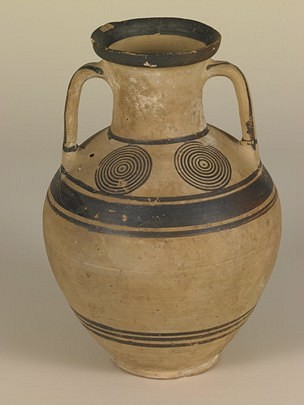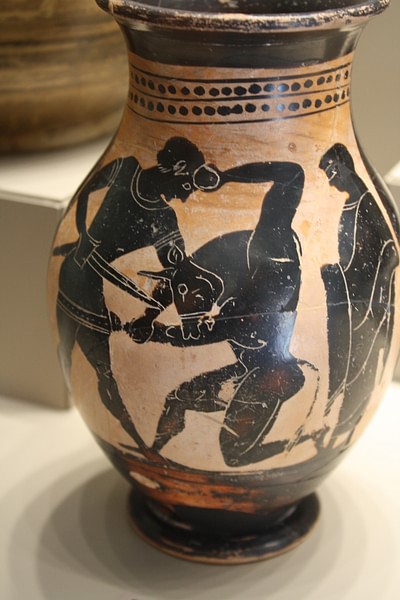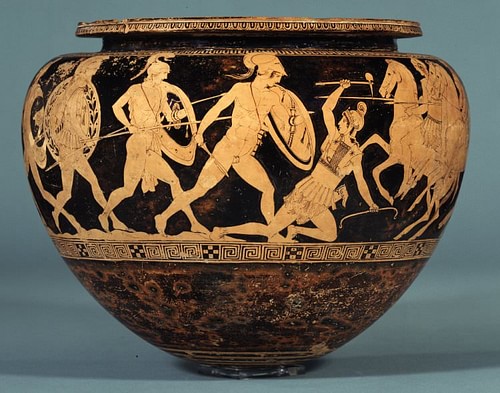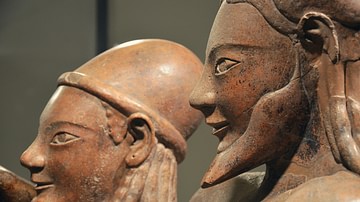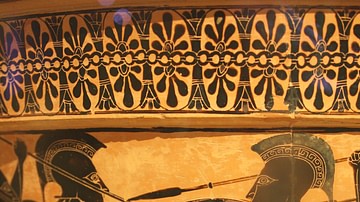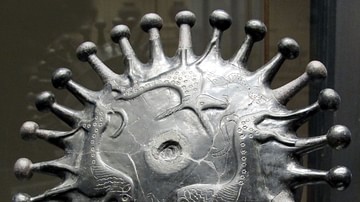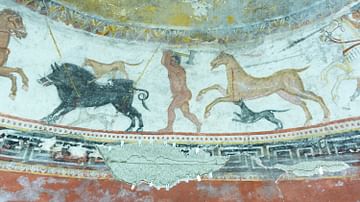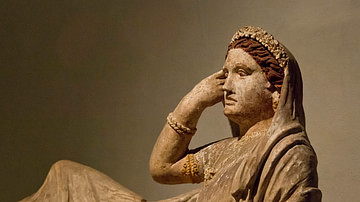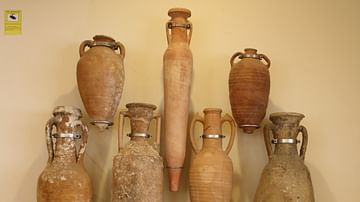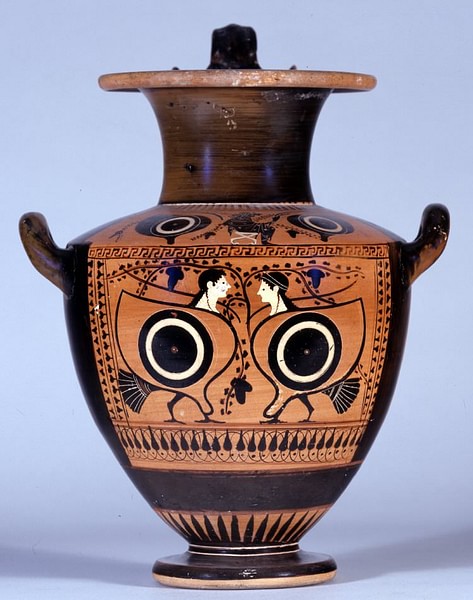
Greek pottery has four main types: Geometric, Corinthian, Athenian Black-figure, and Athenian red-figure pottery. Pottery vessels were made for everyday use such as the two-handled amphora for storage, the single-stem kylix cup for drinking wine, and the three-handled hydra for holding water. Greek pottery was often decorated with geometric designs or images from Greek mythology.
The pottery of ancient Greece from c. 1000 to c. 400 BCE provides not only some of the most distinctive vase shapes from antiquity but also some of the oldest and most diverse representations of the cultural beliefs and practices of the ancient Greeks. Further, pottery, with its durability (even when broken) and lack of appeal to treasure hunters, is one of the great archaeological survivors and is, therefore, an important tool for archaeologists and historians in determining the chronology of ancient Greece. Whatever their artistic and historical value though, the vast majority of Greek vases, despite now being dusty museum pieces, were actually meant for everyday use and, to paraphrase Arthur Lane, it is perhaps worth remembering that standing on a stone pavement and drenched with water, they would have once gleamed in the Mediterranean sun.
Materials & Production
The clay (keramos) to produce pottery (kerameikos) was readily available throughout Greece, although the finest was Attic clay, with its high iron content giving an orange-red colour with a slight sheen when fired and the pale buff of Corinth. Clay was generally prepared and refined in settling tanks so that different consistencies of material could be achieved depending on the vessel types to be made with it.
Greek pottery was invariably made on the potter's wheel and usually made in separate horizontal sections: the foot, the lower and upper body, the neck, and finally the handles, if necessary. These sections were then joined together with a clay 'slip' after drying and it is possible in many cases to see the prints of the potter impressed on the inside of the vessel. The piece was then put back on the wheel to smooth the join marks and add the final shaping. Therefore, all vases were unique and the small variations in dimensions reveal that the use of simple tools and not cut-out templates was the norm.
Next, the pot was decorated. This process depended on the decorative style in vogue at the time, but popular methods included painting the whole or parts of the vase with a thin black adhesive paint which was added with a brush, the marks of which remain visible in many cases. This black paint was a mix of alkali potash or soda, clay with silicon content, and black ferrous oxide of iron. The paint was affixed to the pot by using a fixative of urine or vinegar which burned away in the heat of the kiln, binding the paint to the clay. Another technique, used more rarely, was to cover the vessel with a white clay paint. Alternatively, only lines or figures were added in black using a thicker version of the black paint mentioned above and applied with a stiff brush or feather; in consequence, a slight relief effect was achieved. Minor details were often added with a thinned black paint giving a yellow-brown colour, a white pipe-clay, and a dark red of ochre and manganese. The latter two colours tended to flake off over time.
The finished pot was then ready to be put in the kiln and fired at a temperature of around 960 °C, which is relatively low and explains the 'softness' of Greek pottery (in comparison to, for example, Chinese porcelain). Pots were fired several times (in the same kiln) in order to achieve the required finish and colouring. First, the pot was fired in an oxidising fire where good ventilation to the kiln ensured that the orange/red of the clay came to the fore. Then the pot was re-fired in a kiln starved of oxygen (reduction process) by adding water or damp wood inside the kiln. This ensured that the painted colours, particularly the black, darkened in colour. A third firing, again with good ventilation, re-reddened the clay of the pot whilst the painted areas, now protected by a thin wash, kept their original colouring. This complicated process obviously required excellent timing from the potter so as not to spoil the vase with unseemly discolouring.
Greek Potters & Painters
Painter and potter (kerameus) were usually, although not always, separate specialists. However, lasting partnerships existed such as between the potter Ergotimos and painter Kleitas. Many individual potters and less frequently, painters, have been identified with certainty through their signatures (most commonly as “...made this”) although the majority of Greek vases are unsigned. However, Professor J. D. Beazley, working in the 20th century CE, identified more than 500 unsigned artists distinguishable through their particular style. Beazley's systematic and comprehensive cataloguing of Greek pottery has also allowed for the study of its evolution in techniques, designs, and decoration.
Painters often worked in collective workshops, generally under the supervision of one 'master' potter (which suggests form was actually more important than decoration for the Greeks). Although artists were free from centralised political control or restrictions, they no doubt were driven by the market demand for particular styles, subjects, and fashions. Many potters and artists were prolific in their output and in some cases over 200 vases may be attributed to a single artist. The majority of pottery workers would have been paid no more than any other manual labourer and a good vase probably cost only a day's wages. Certainly though, a few artists would have been in great demand and their goods were sold not only locally but far and wide throughout the Mediterranean. Potters themselves sometimes relocated to other cities, particularly colonies, often taking with them their regional style. There was also some rivalry between artists as indicated by one signed comment on a vase, “better than Euphronias could ever have done”.
The Shapes of Greek Pottery
Although Greek pottery provides us with a wide range of shapes from cups to plates to massive amphorae, many of the forms remained relatively constant over centuries. This is primarily because Greek potters were producing wares for practical use - holding wine, water, oil, and perfumes - and once the optimum practical shape had evolved, it was copied and maintained. However, despite this restriction in form, the Greek potters and painters could express their versatility in the decoration of the vase.
The most common forms of pottery were amphorae for storing wine, large kraters for mixing wine with water, jugs (oinochoai) for pouring wine, kylixes or stemmed cups with horizontal handles for drinking (especially practical if lifting a cup from the floor when reclining on a lounger at dinner), hydra with three handles for holding water, skyphoi or deep bowls, and lekythoi jars for holding oils and perfumes. Precisely because these objects were for practical use, handles (when present) are generally sturdy affairs, yet the potter, by using carefully considered shapes, often managed to blend these additions into the overall harmony of the vessel and was aided in this endeavour with subtle decorative additions by the painter.
Decorative Styles: Proto-Geometric Pottery
Greek pottery, particularly in terms of decoration, evolved over the centuries and may be categorized into four broad groups:
- Proto-geometric pottery
- Geometric pottery
- Black-figure pottery
- Red-figure pottery
These groups or styles, however, did not pass abruptly from one to the other but rather in some cases ran contemporary for decades. Also, some city-states and regions were either slow to catch on to new styles or simply preferred the 'old' style decoration long after they had gone out of production elsewhere. In addition, some cities and regions were consistently a little eccentric in their decoration (notably Laconia-Sparta, Cyprus, Crete, and Boeotia) and preferred to follow their own artistic path rather than imitate the styles of the more dominant centres such as Athens and Corinth.
The first distinctive Greek pottery style first appeared around 1000 BCE or perhaps even earlier. Reminiscent in technique of the earlier Greek civilizations of Minoan Crete and the Mycenaean mainland, early Greek pottery decoration employed simple shapes, sparingly used. Proto-Geometric pottery, however, differs from Minoan and Mycenaean in shape. The centre of gravity of the vase is moved downwards (creating a more stable vessel) with the feet and neck more articulated.
The most popular Proto-Geometric designs were precisely painted circles (painted with multiple brushes fixed to a compass), semi-circles, and horizontal lines in black and with large areas of the vase painted solely in black. A new motif on the bases of vessels was the upright triangular points which would endure for centuries and become a staple feature of the later black-figure pottery design.
Geometric Pottery
From around 900 BCE the full Geometric style appeared and favoured the rectangular space on the main body of the vase between the handles. Bold linear designs (perhaps influenced by contemporary basketwork and weaving styles) appeared in this space with vertical line decoration on either side. It was in this period that the Maeander design first appeared (perhaps inspired by the practice of wrapping leaves around the rims of metal bowls), destined to become forever associated with Greece and still going strong on everything from plates to beach towels even today. The lower portion of Geometric vessels were often painted in black and separated from the rest of the vase using horizontal lines. An interesting Geometric style shape appeared which was the circular box with a flat lid, on top of which, one to four horses acted as a handle.
From the 8th century BCE, Geometric pottery decoration began to include stylized human figures, birds, and animals with nearly all the surface of the vase covered in bold lines and shapes painted in brown and black. Towards the end of the period in the 7th century BCE, the so-called Orientalising style became popular in Corinth. With its eastern trade connections, the city appropriated the stylised plants (e.g. lotus, palm, and the tree of life), animal friezes (e.g. lions), and curved lines of Egyptian and Assyrian pottery to produce its own unique Greek version. The rest of eastern Greece followed suit, often preferring red on a white slip background. Athens also followed the new trend and it became widespread with, for example, the Cyclades also producing pottery in this new freer style, often on very large vases and with more spacious decoration.
At the end of the 7th century BCE, Proto-Corinthian pottery reached new heights of technique and quality producing the finest pottery yet seen, in firing, shape, and decoration. The black stylized figures became more and more precisely engraved and were given ever more detail, grace, and vigour. The celebrated black-figure pottery style was born.
Black-figure Pottery
Although first produced in Corinth, then with fine examples made in Laconia and southern Italy (by Euboean settlers), it would be the potters and painters of Attica who would excel above all others in the black-figure style, and they would go on to dominate the Greek market for the next 150 years. Not all figures were painted black as certain colour conventions were adopted, such as white for female flesh and purple-red for clothes and accessories. A greater interest in fine details such as muscles and hair, which were added to the figures using a sharp instrument, is characteristic of the style. However, it is the postures of the figures which also mark out black-figure pottery as the zenith of Greek vase painting. The finest figures are given grace and poise and often illustrated in the moments before actual movement or resting after exertion.
The famous vase by Exekias, with Ajax and Achilles playing a board game during the Trojan War, is an excellent example of the dignity and energy black-figure painting could achieve. In addition, black-figure vases often told, for the first time, a narrative. Perhaps the most celebrated example is the Francois Vase, a large volute krater made by Ergotimos and painted by Kleitas (570-565 BCE) which is 66cm high (26 inches) and covered in 270 human and animal figures depicting an astonishing range of scenes and characters from Greek mythology. Typical other vessels of the black-figure style are amphorae, lekythoi, kylixes, plain cups, pyxides (small lidded boxes) and bowls.
Red-figure Pottery
The black-figure technique was replaced by the red-figure technique (red figures created by painting their outline with a black slip background) around 530 BCE which would endure for the next 130 years or so. The two styles were parallel for some time and there are even 'bilingual' examples of vases with both styles but the red-figure, with its advantage of the brush over the graver, could attempt to more realistically portray the human figure and eventually it became the favoured style of Greek pottery decoration. Perhaps influenced by contemporary wall painting techniques, anatomical detail, diverse facial expressions, greater detail in clothing (especially of folds, following the new fashion of the lighter chiton dress which also fascinated contemporary sculptors), greater attempts at portraying perspective, the overlapping of figures, and the depiction of everyday life such as education and sporting scenes are all characteristic of this style.
The shapes of red-figure vessels are generally those of the black-figure style. An exception is the kylix which becomes shallower and with a shorter foot, almost becoming a third handle. In addition, the painted narrative is to be read by turning the cup in the hand. Other minor modifications are the hydra, which becomes a little fuller in figure and the slimmer neck-amphora. Lekythoi of this period commonly had a white background as did (more rarely) cups and boxes.
New Media
Into the fourth century BCE, perhaps in attempting to copy the innovations in perspective of contemporary fresco, the red-figure style would reveal its limitations and vases would degenerate into over-packed scenes with strange floating perspectives. Significantly, pottery painting would no longer be linked intrinsically to the form which it decorated and so ceased to exist as an art-form in its own right. Consequently, artistic attention and excellence would turn away from the confinements of pottery to other more open media such as wall-painting.
Conclusion
In conclusion, then, we may say that not only has Greek pottery given us some of the most distinctive, influential, and beautiful shapes and designs of antiquity but it has also given us a window into the lives, practices, and beliefs of a people long gone and of whom we very often have no contemporary written record. These everyday objects, unlike those other archaeological survivors literature, sculpture, and architecture, allow us to feel a little closer to the ordinary people of the ancient world, those who could not afford fine art or precious jewellery but could indulge in possessing a finely made object such as a Greek vase.
